Yves GARY
Hits: 5881
Category: MARIA
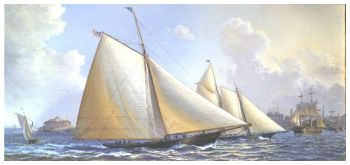 As originally built the Maria had a full, round bow, though with a shallow and easy entrance, in effect not unlike the "scow" bow of racers of today, her draft at the cutwater being only 8 inches.
As originally built the Maria had a full, round bow, though with a shallow and easy entrance, in effect not unlike the "scow" bow of racers of today, her draft at the cutwater being only 8 inches.
Her original lines are said to have been suggested by those of the North River sloop Eliza Ann, which, though not a yacht, showed great speed for those days. When launched the Maria was 92 feet long on deck.
In 1850 she was lengthened by the addition of 18 feet to her bow, which made it long and sharp.
 Her dimensions were then : length on deck 110 feet, waterline 107.9, beam 26 feet 6 inches, depth 8 feet 4 inches, greatest draft 5 feet 2 inches. Her centerboard, 24 feet long, with a draft of 20 feet, was heavily weighted, and was raised by the aid of strong spiral springs from which one end was suspended. Her outside lead ballast was fixed to the hull in strips, and covered with copper sheathing.
Her dimensions were then : length on deck 110 feet, waterline 107.9, beam 26 feet 6 inches, depth 8 feet 4 inches, greatest draft 5 feet 2 inches. Her centerboard, 24 feet long, with a draft of 20 feet, was heavily weighted, and was raised by the aid of strong spiral springs from which one end was suspended. Her outside lead ballast was fixed to the hull in strips, and covered with copper sheathing.
The Maria was heavily sparred, her mast being 92 feet long, and 2 feet 8 inches diameter at the deck. For the first 20 feet it was bored out to a diameter of 12 inches, in the next 20 feet to 10 inches, and the rest of the way to 7 inches. Her main boom was 95 feet long and hollow, being made of white oak staves, dowelled and hooped with iron, strengthened with inside trusses, and outside rods and struts, and nearly nine feet in circumference in its thickest part. Her gaff was 61 feet long, and bowsprit 38 feet outboard, entering the hull below decks.
The area of her mainsail was 5790 square feet, and of her jib 2100 square feet, making a total working sail-spread of 7890 square feet. She had a small working-topsail, but it was rarely set. On her mainsheet traveler was a rubber compressor to take up strain, the first one used on a yacht. She steered with a 12-foot tiller, and to prevent her from yawing when off the wind she had a small centerboard aft.
THE BUILDING OF THE MARIA
BY WILLIAM P. STEPHENS (TRADITIONS AND MEMORIES OF AMERICAN YACHTING)
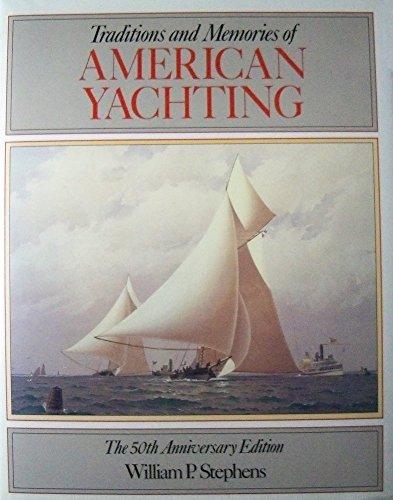 THE builder of Maria was William Capes, at the foot of Second Street, Hoboken. She was built of wood, with the heavy construction of the working sloops; but luxuriously fitted below. One peculiarity was the housing of her bowsprit under instead of above the deck. Her centerboard, in a trunk immediately abaft the mast, was 24 feet long, and not pivoted on a pin but suspended by chains at each end. The weight of the "board" was 7 tons, the first one being of cast iron; others of wood weighted. The lifting mechanism included a horizontal shaft for the full length of the trunk with a barrel at each end carrying a chain; the forward barrel being the smaller, the after end of the board dropped to a greater depth, 15 feet, with hut 13 feet forward. The shaft was operated by two winches, each requiring four men, with an extra man to handle the pawl. Spiral springs were fitted to take a part of the weight. Steered with a 12-foot tiller, she was hard to handle and when the final lengthening was done in 1858 a second centerboard was added 10 feet forward of the sternpost, 8 feet long and with a drop of 5 feet.
THE builder of Maria was William Capes, at the foot of Second Street, Hoboken. She was built of wood, with the heavy construction of the working sloops; but luxuriously fitted below. One peculiarity was the housing of her bowsprit under instead of above the deck. Her centerboard, in a trunk immediately abaft the mast, was 24 feet long, and not pivoted on a pin but suspended by chains at each end. The weight of the "board" was 7 tons, the first one being of cast iron; others of wood weighted. The lifting mechanism included a horizontal shaft for the full length of the trunk with a barrel at each end carrying a chain; the forward barrel being the smaller, the after end of the board dropped to a greater depth, 15 feet, with hut 13 feet forward. The shaft was operated by two winches, each requiring four men, with an extra man to handle the pawl. Spiral springs were fitted to take a part of the weight. Steered with a 12-foot tiller, she was hard to handle and when the final lengthening was done in 1858 a second centerboard was added 10 feet forward of the sternpost, 8 feet long and with a drop of 5 feet.
At the same time outside ballast was added by an unusual operation. A mould was built under the bottom for a length of twenty feet, leaving a space five inches deep at the rabbet tapering out to a shim edge at the turn of the bilge. Melted lead was poured into this space through holes in the bottom planking; when the lead had been smoothed off it was covered with copper in the usual way. The rig was that of the working sloops, a huge mainsail and jib, a gaff topsail being seldom used. The mast was 92 feet, deck to hounds, 32 inches diameter at the deck and 23 inches at the hounds. It was bored out hollow; 12 inches diameter for the first 20 feet, 10 inches for the second 20 feet, and 7 inches to the hounds. It was “stream-lined" by triangular oak battens on both forward and after sides. In 1816 a mast track and slides were fitted on Trouble and later on Onkahye. The track on Maria was of channel iron with four-wheeled trolleys of brass to which the luff was lashed. The bowsprit was 27 feet outboard and hollow. The boom, 92 feet long, was 31 inches in diameter in the middle and 26 inches in the slings. It was built like a barrel, with staves of white pine 2½ by 2½ inches, dowelled to prevent slipping, and hooped with iron bands. It was trussed inside by iron rods and also by outside rods over wiskers three feet long. The hollow gaff was 50 feet long (some say 60) and 9 inches diameter; the hollow club on the foot of the jib was 70 feet long. The main sheet horse was fitted with rubber compressors: the sails were crosscut, in modern fashion.
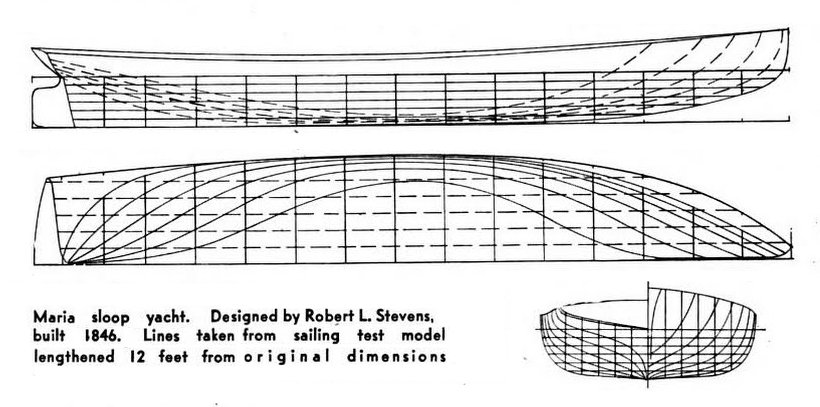
The area of the mainsail is given as 5,190 square feet; of the jib, 2,100; a total of 1,890 square feet. While these figures are on record they cannot be relied on, as dates are not given and many changes in the spars were made with the various alterations in the hull. When re-rigged as a schooner the sail area is given as 12,000 square feet. Under the rules of the Club, she was allowed a crew of 55 as a sloop and 39 as a schooner; she was obliged to carry one 12-foot boat.
After the dead of John C. Stevens on June 10, 1857, a year after the death of Robert, Edwin succeeded as Commodore down to 1869; on his death Maria was sold to a Captain Buckalew who re-named her Maud and used her for carrying fruit from Honduras to New York. She sailed from New York on July 15, 1870, returned in September and sailed on what was destined to be her last voyage. She never was heard from and the presumption is that she was lost in a heavy gale which swept the coast on October 6. Her racing career was uneven. She outclassed in size all of her competitors; she was raced under varying systems of measurement, most of them very defective; she showed bursts of speed under favorable conditions. In the very inconclusive trials with the new America before the latter's departure for England she was easily superior. She is most notable as an example of the ingenuity of one of the first of America's great engineers.
| MARIA : DATA TABLE |
| Designer |
Robert Livingston Stevens |
| Builder |
William Capes |
| Owner |
John C. and Edwin A. Stevens |
| Club |
|
| Cup |
|
| Skipper |
|
| Afterguard |
|
| Launching |
1846 |
| Type |
Sloop |
| Hull material |
Wood |
| Mast material |
Wood |
| L.O.A. |
110 feet (first measurements) |
| L.W.L. |
97 feet |
| Beam |
26 feet 6 inches |
| Draft |
5 feet 2 inches |
| Mainmast |
92 feet |
| Mainboom |
95 feet |
| Bowsprit |
38 feet |
| Maintopmast |
|
| Maingaff |
61 feet |
| Displacement |
145 tons |
| Sail area |
7890 sq.ft. |
| End of life |
Lost at sea in October 1870 |
|
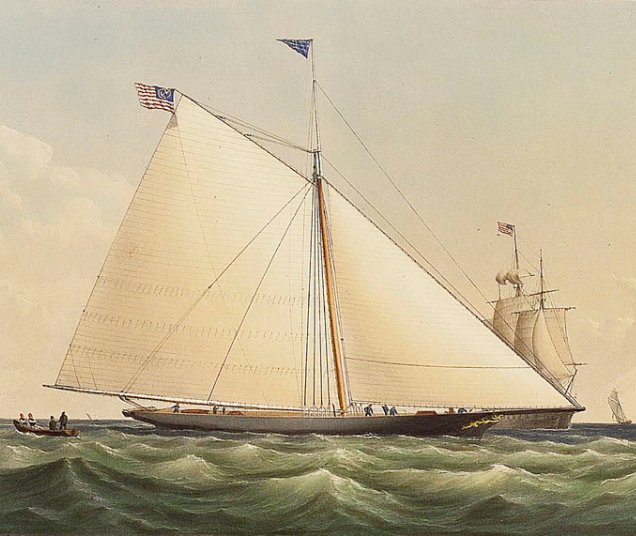 |
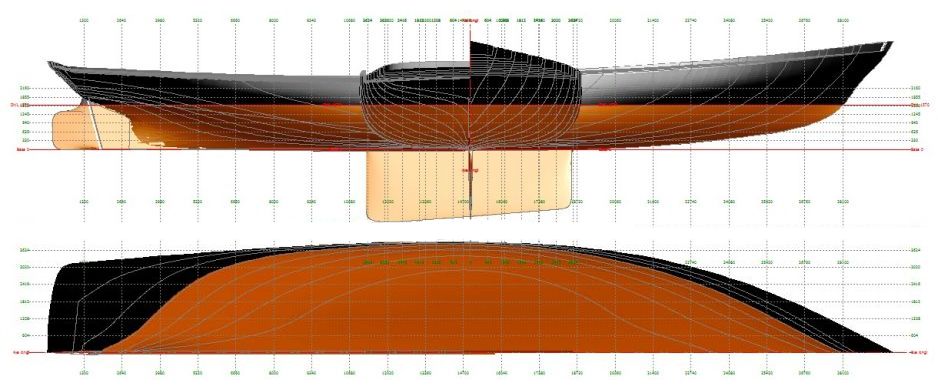

Download DELFTSHIP LINES : Delftship file to finish and background images


 As originally built the Maria had a full, round bow, though with a shallow and easy entrance, in effect not unlike the "scow" bow of racers of today, her draft at the cutwater being only 8 inches.
As originally built the Maria had a full, round bow, though with a shallow and easy entrance, in effect not unlike the "scow" bow of racers of today, her draft at the cutwater being only 8 inches.  Her dimensions were then : length on deck 110 feet, waterline 107.9, beam 26 feet 6 inches, depth 8 feet 4 inches, greatest draft 5 feet 2 inches. Her centerboard, 24 feet long, with a draft of 20 feet, was heavily weighted, and was raised by the aid of strong spiral springs from which one end was suspended. Her outside lead ballast was fixed to the hull in strips, and covered with copper sheathing.
Her dimensions were then : length on deck 110 feet, waterline 107.9, beam 26 feet 6 inches, depth 8 feet 4 inches, greatest draft 5 feet 2 inches. Her centerboard, 24 feet long, with a draft of 20 feet, was heavily weighted, and was raised by the aid of strong spiral springs from which one end was suspended. Her outside lead ballast was fixed to the hull in strips, and covered with copper sheathing.

